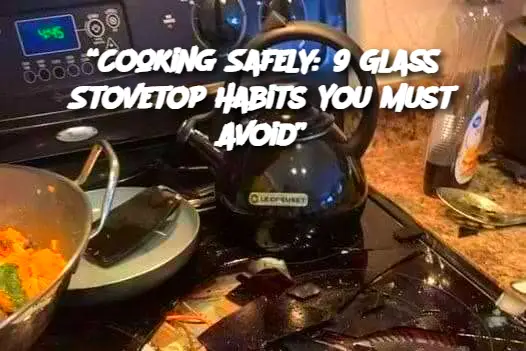ADVERTISEMENT
Introduction
Glass stovetops are sleek, modern, and efficient—but they also require a bit more care than traditional coil or gas burners. Despite their sturdy appearance, glass-ceramic stovetops are susceptible to scratches, cracks, and other damage when misused. To help you keep your stovetop in top shape and your kitchen safe, we’ve compiled a list of the nine most dangerous habits people fall into when using glass stovetops—and how to avoid them.
—
Ingredients (a.k.a. The Common Culprits):
You won’t find flour or eggs here—this recipe includes:
-
Heavy pots and pans
-
Abrasive cleaners
-
Sugar spills
-
Cast iron cookware
-
Dragging motions
-
Overflowing pots
-
Unattended cooking
-
Incorrect cookware sizes
-
Sudden temperature changes
—
Preparation (Avoid These 9 Dangerous Habits):
-
🧱 Using Heavy or Uneven Cookware
Slamming a heavy pot—especially cast iron—can crack your glass surface. Always lift, never drag, and consider using lighter cookware with smooth bottoms. -
🧽 Cleaning With Abrasive Materials
Avoid steel wool or gritty powders. These can permanently scratch your stovetop. Instead, use a soft sponge or microfiber cloth with a cleaner made specifically for glass surfaces. -
🍭 Letting Sugar or Syrup Spill
Sticky, sugary spills can pit the surface if not cleaned quickly. If something boils over, turn off the burner and let the surface cool before cleaning with a damp cloth. -
🛠 Cooking With Cast Iron (Directly)
Cast iron holds heat too well and often has rough bottoms. If you must use it, place a heat diffuser between the cookware and the glass stovetop. -
🌀 Dragging Pots Instead of Lifting
Dragging cookware can cause micro-scratches. Always lift your pans when repositioning them. -
🌊 Letting Pots Boil Over
Boil-overs not only create a mess—they can cause stains and etch the glass. Use appropriately sized pots and monitor water levels carefully. -
🚨 Leaving the Stove Unattended
It’s easy to step away and get distracted. But unattended cooking can lead to burned food, stubborn stains, or worse—fires. -
📏 Using the Wrong Pan Size
A pan too small or too large can cause uneven heating. Match the pan size to the burner ring for optimal performance and safety. -
❄️ Placing Cold Cookware on a Hot Surface (or Vice Versa)
Sudden temperature changes can cause thermal shock, leading to cracks. Let glass cookware adjust gradually to temperature shifts.
—
Serving and Storage Tips (Maintenance & Longevity):
-
After each use, wait until the surface is cool before wiping it clean.
-
Store cookware safely to prevent accidental knocks.
-
Use stovetop covers or mats when not in use to prevent dust and accidental impacts.
—
Variations (What You Can Use Instead):
ADVERTISEMENT
